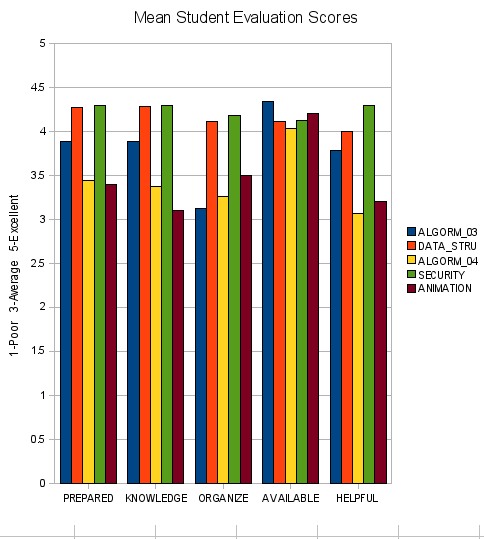Teaching philosophy available upon request from aneeman[at]cse[dot]ucsc[dot]edu
I have been a teaching assistant for a wide variety of upper-level undergraduate courses, ranging from Data Structures to Computer Security. The classes have been taught largely in C, C++, and Java. For some courses, the students were allowed to program in the language of their choice.
| 09/2003 - 12/2004 | Teaching Assistant, UC Santa Cruz |
|
Data Structures (in C), Algorithms, Computer Security,
Visualization and Animation Created some homework assignments, conducted lab including pedagogical and programming component, grading | |
| 2002 - 2003 | Teaching Assistant, SUNY Binghamton |
| Internet Programming (Java), Network Security
(Java/C),
Data Structures (C++) Occasional substitute lecturer, created course module on packet sniffing for security course, grading, supervised lab, student programming support | |
I have taught two short courses. First, I gave a short course on HTML for 5th and 6th graders of both genders in the Kids Explore! Science Camp at Binghamton University. During the course the students created web pages about their week-long science camp experience. Photos were available of themselves building robots, designing games, etc. I took the approach that HTML is a language, but it's a language that is only written (not spoken).
For the first half of the course, the students learned basic HTML tags that allowed them to create pages and customize them. They experimented, changing font color, background color and adding images while learning syntax. For the second half, I introduced the students to a web page editing program. Their creativity took off as they added content and customized the pages to their own satisfaction. At the end, they all proudly affirmed that they now knew two languages.
The other course was English Conversation for graduate students from Japan, part of the English Language Program at the UCSC Extension. The purpose of the course was to help students give technical presentations in English and improve their langauge and conversation skills. I had several goals in designing the conversation sessions:
- Create an environment that encouraged conversation
- Assure all students a chance to participate, despite varying ability and personality (shy vs. outgoing)
- Assist students as they began to prepare their technical
presentation
Course slides I've made (Animation slides partially based my advisor's notes).
- Network Packet Sniffing
- BehavioralAnimation.ppt
- PhysicallyBasedModeling.ppt
- ParticleSystems.ppt
- Morphing.ppt
- Quaternions.ppt
- Kinematics.ppt
The chart below shows the the results of student evaluations for the course I TA'd at UC Santa Cruz. I was evaluated on five criteria: level of preparation, command of material, organization in presenting material, availability for help outside class, and helfulness explaining new material. All scores are above average (3/5), and for two classes, Data Structures and Security, the scores average Very Good (4/5).

|
Below are student comments from the last course I TA'd, Animation and Visualization. In addition to TA duties, I taught the class for two weeks while the instructor attended a dissertation defense overseas.
Alisa is very helpful. She is among the best TAs I have had. I especially appreciate her willingness to work 1-on-1 on assignment troubleshooting. A+.
She might not know some stuff, but if you ask her for something she will always find the information and explain it. Excellent TA, best I had in my 5 years at UCSC.
She ended up teaching the last half chunk of the class. With what she had to work with she did an excellent job. She was always available at lab time and did not care if I was the only one who showed up or if I showed up multiple times in a week. Very dedicated.
Very clear and explained concepts in a much easier to understand manner than the instructor.